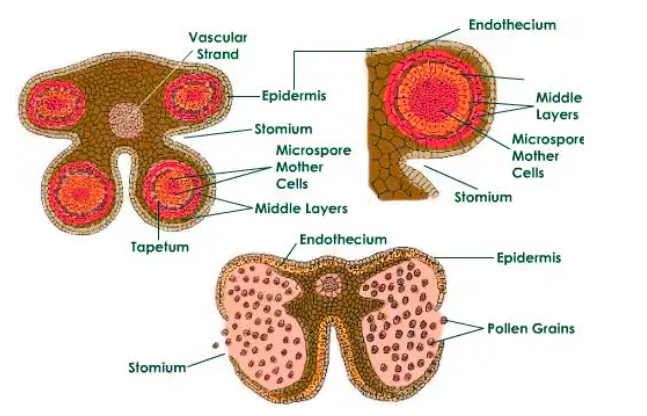
Endothecium layer of anther lobes is present:
A) Outside the epidermis
B) inner to epidermis
C) In the innermost layer
D) in the middle region
Answer
320.1k+ views
Hint: The endothecium is in charge of the tensions that result in anther dehiscence or splitting. This is caused by the uneven thickness of the cell walls. The cells lose water, and the uneven thickness causes the thinner cell walls to stretch more. This causes tension, which eventually causes the anther to split along its line of weakness, releasing pollen grains into the atmosphere.
Step by step solution:
In angiosperms, the microsporangium is the sporangial structure that contains microspores, which are pollen sacs that give rise to male gametes. In the transverse section, a microsporangium has a circular outline and is usually surrounded by four wall layers. The epidermis is the single layer on the outside. Endothecium is the second layer, where cells thicken. It is often made up of larger cells with secondary wall thickenings that aid in yet another dehiscence.
The middle layer consists of 2-4 cells. The innermost layer is tapetum, which feeds the developing pollen cells. Tapetum cells can have multiple nuclei. The outer three layers serve a protective purpose. They also aid in pollen dispersal by dehiscing themselves. Inside, there are four pollen sacs. The microsporangium's center is made up of compact sporogenous tissue.

Hence, option B is the correct answer.
Note:
The endothecium layer is the second layer from the outside of the anther and serves as a protective layer.Endothelial cells in a typical anther develop fibrous -cellulose thickenings on the inner and radial walls and die. The endothecium is also known as the fibrous layer due to the presence of fibrous thickenings.
Step by step solution:
In angiosperms, the microsporangium is the sporangial structure that contains microspores, which are pollen sacs that give rise to male gametes. In the transverse section, a microsporangium has a circular outline and is usually surrounded by four wall layers. The epidermis is the single layer on the outside. Endothecium is the second layer, where cells thicken. It is often made up of larger cells with secondary wall thickenings that aid in yet another dehiscence.
The middle layer consists of 2-4 cells. The innermost layer is tapetum, which feeds the developing pollen cells. Tapetum cells can have multiple nuclei. The outer three layers serve a protective purpose. They also aid in pollen dispersal by dehiscing themselves. Inside, there are four pollen sacs. The microsporangium's center is made up of compact sporogenous tissue.

Hence, option B is the correct answer.
Note:
The endothecium layer is the second layer from the outside of the anther and serves as a protective layer.Endothelial cells in a typical anther develop fibrous -cellulose thickenings on the inner and radial walls and die. The endothecium is also known as the fibrous layer due to the presence of fibrous thickenings.
Recently Updated Pages
Given diagram showing a typical agarose gel electrophoresis class 13 biology NEET_UG

Capping is a process in which A adenylate is added class 12 biology NEET_UG

Explain in brief the separation and isolation of DNA class 12 biology NEET_UG

Number of testicular lobules in testes is A 250 B 500 class 12 biology NEET_UG

Master Class 12 Business Studies: Engaging Questions & Answers for Success

Master Class 12 Economics: Engaging Questions & Answers for Success

Trending doubts
What is BLO What is the full form of BLO class 8 social science CBSE

Which places in India experience sunrise first and class 9 social science CBSE

Differentiate between an exothermic and an endothermic class 11 chemistry CBSE

The shortest day of the year in India

What are the major means of transport Explain each class 12 social science CBSE

Which are the Top 10 Largest Countries of the World?




